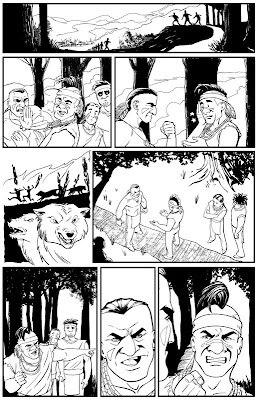 I spent the better part of the day inking this page. The "inks" were done digitally. I have scan of my pencils on one layer in Photoshop at 50% opacity and I "ink" on a layer above it. The background trees were done on a layer in between. This way I don't have to cut the background from the foreground if I want to do some kind of FX. Big time saver.
I spent the better part of the day inking this page. The "inks" were done digitally. I have scan of my pencils on one layer in Photoshop at 50% opacity and I "ink" on a layer above it. The background trees were done on a layer in between. This way I don't have to cut the background from the foreground if I want to do some kind of FX. Big time saver.

5 comments:
Hi Gene,
Question. If you did not have the aid of computer technology, how long would it take you to ink one page?
One page done, and it looks good!
Gary
The page looks fantastic. I am interested in what constitutes digital inking. Do you "digitally" go over the pencil strokes with a Wacom tablet stylus or do you manipulate the levels/colors/opacity of the pencil scans themselves? Whatever method, I would think that the possibilities of experimentation can lead to incredible results with the editing or "do-overs" that digital media allows. You can go crazy without ruining the piece or wasting a lot of time as is the case when you are working with paper.
Gary, Digital inking saves me a little bit of time. This page was about 4 hours at the most. If I had done it traditionally, it might have been 5. But then after scanning it I would have to go in and clean it up. Zooming in on areas that need to be adjusted and prepping the page to be colored. All of which could add another 30-45 mintues. If you go back and look at the pencils I posted, and compare them to the inks, You will see I moved things around and reduced and enlarged areas. Things that would have been harder to do if I had used ink. I tend to ink digitally when there is very little chance of the original art being purchased. I have pages and pages of the first two books that haven't sold so I figure this will be the same. It also gives me a chance to experiment with Photoshop. Thanks for the question!
Royce- I do my pencils at on 11" x 17" bristol board, scan it and save it. I keep a master scan of the pencils at 600dpi. I then resave the file at 450 dpi and make this my work file. I then create a layer I call "inks-forground" and a layer below it called "inks-background". The pencil layer is below both and the opacity is set to 50%, making it gray. I use my stylus pen on my Wacom tablet and proceed to ink with the pencil tool using solid black. No gray pixels. I will use some texture "brushes" with my pencil tool as well. Much like using a toothbrush or other items with ink on a board. When inking, some areas might get outlined and then filled with black, while others will be handled using the pressure sensitive pen on the tablet to get the thick to thin line weight I would get with a brush on a board. I also use the pen tool for long curved lines that I can't get in one stroke because of the inability to rotate the art on the screen like I would on a board. Though I hear Photoshop CS4 has the function now.
The process of using levels to get my pencils dark enough is another way to go but that would involve tighter penciling and more cleaning up. Probably wouldn't take any longer, just a different approach for a different effect. I do that with spot illustrations all the time and would like to do a comic using that process sometime. I hope that answers your question. Thanks!
Thanks for the detailed answers Gene! We really appreciate your taking the time to individually answer each of our posts.
Hey Royce, no problem. I enjoy the questions and appreciate the interest! :)
Post a Comment